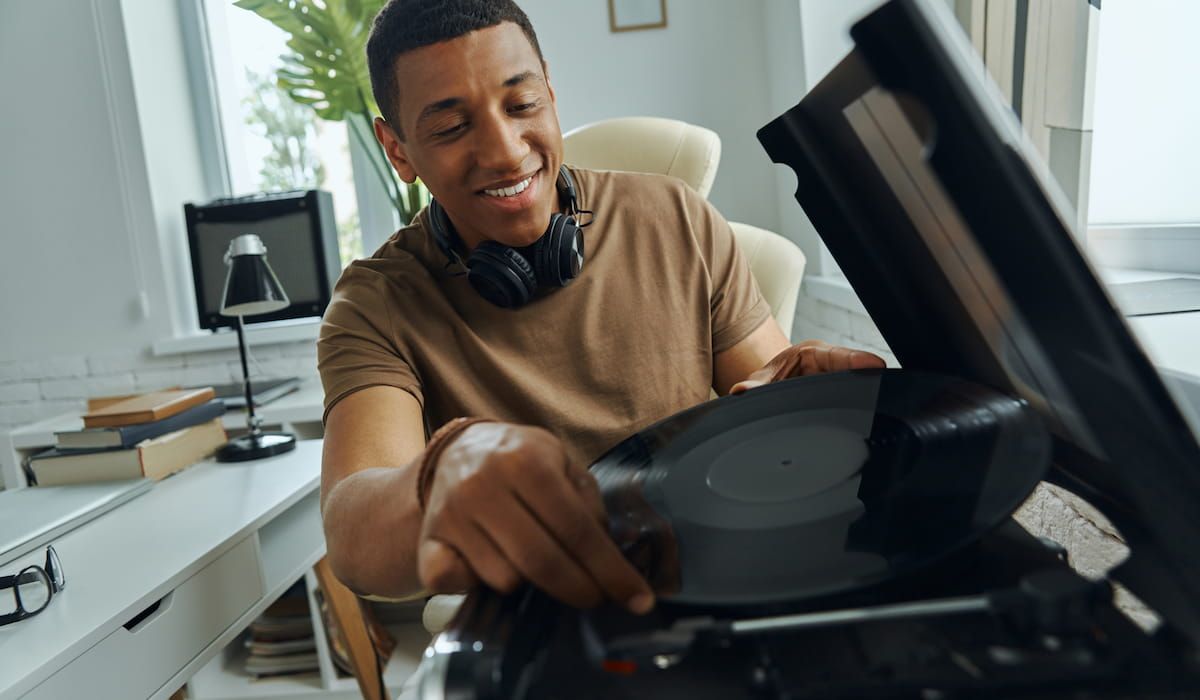Have you been considering vinyl record collecting? Even though vinyl records have been around for decades, this remains a hobby that is quite popular.
It’s perfect for music lovers, it’s fun, it’s decorative, and it can even be lucrative (some consider vinyl record collecting to be an investment).
If you like vinyl records, what more can you ask?
When Did Vinyl Records Come to Be?
The records we know today started out as basic phonographs (which were wildly innovative for their time). These played phonographic cylinders, which were around from about 1877 to the early 1880s.
In the late 1880s, records came to be made of all kinds of materials, most notably rubber. These were followed by shellac records, in 1895.
Vinyl records were invented in the early 1959s and remain ever popular. They require a vinyl record player.
Records are a storage media for music primarily, but you can also find records with poetry, presidential speeches, nature sounds, etc.
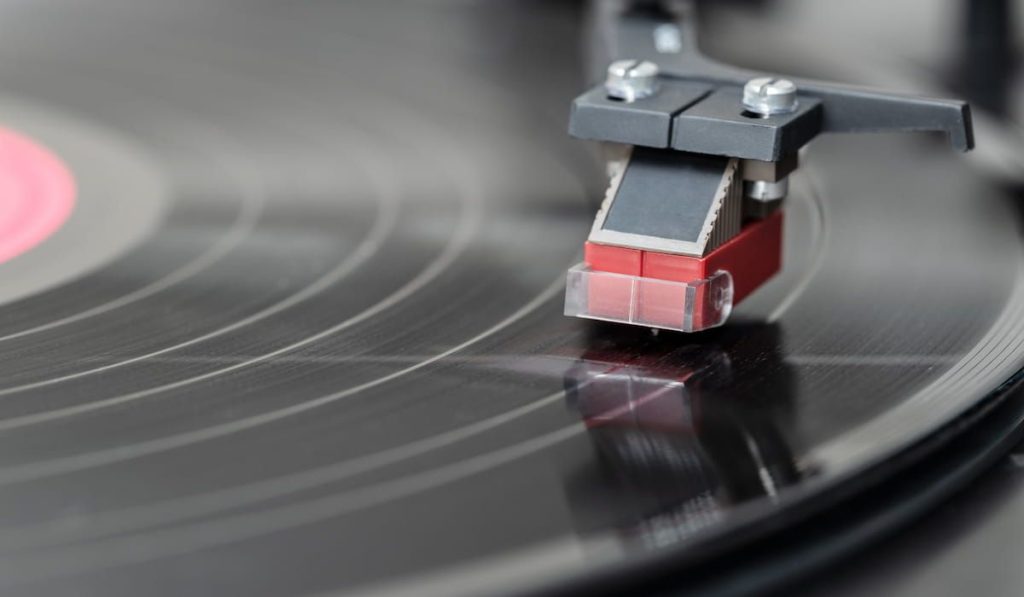
Why Are Vinyl Records Still So Popular?
It’s Fun
If you’re into vinyl records, then you’ll probably find collecting them to be quite fun. When you discover a valuable record or one by a favorite artist, you’ll likely experience a bit of a thrill.
Especially because finding certain records can be a bit tricky – it takes determination and skill.
You can find vinyl records at flea markets, rummage sales, garages sales, second-hand stores, and thrift shops, even some music and bookstores that are old-school.
Since most people are not experts on records, they may not even know that what they have is valuable (but you will!).
You Can Fuse Vinyl Record Collecting with Your Home Decor
Have you ever seen a place decorated with vinyl records? Perhaps a classy cafe, or a friend’s house? If you’re considering vinyl record collecting, you might also consider making your records part of your decor.
They have warm, nostalgic vibes, and many also feature very cool artwork. The cover art is a large part of why vinyl records are so highly sought-after.
Vinyl records can give a room life and character.
In the kitchen, it can set the ambiance for a meal. And where better to display your records than the room with your record player?
Vinyl record decor is also a great conversation starter.
Vinyl Record Collecting Can Be a Rewarding Investment
You can find vinyl records on eBay at an average of about $15-$50 each. For some records, the value will go up over time, however.
This means that you could potentially purchase a record for, say, $20, and in even just a few years, they could go up a great deal.
Depending on the record, some bought at $20 could become worth as much as $200, or more! This means that collecting records is not just a music lover’s hobby, but it can be lucrative, as well. Or even just pay for itself.
The most valuable records right now are Bob Dylan, The Free-Wheelin’ Bob Dylan, 1963; the Beatles white album, 1968; David Bowie, Diamond Dogs, 1974; Hank Mobley, Blue Note 1568; 1957, and more….
What Makes Vinyl Records Special?
Vinyl records are made of polyvinyl chloride (also known as PVC), carved with an intricate series of grooves.
These grooves are literally the physical manifestation of sound waves. This creates an incomparably pure sound quality – one which has made many music-lovers avid fans of vinyl.
Who Can Collect Vinyl Records?
Who can collect vinyl records? Anybody, as long as you know how to keep them in good repair. It is best to keep your records in their sleeves, or some sort of case, as dust can cause them to not work as well.
It’s also advised to touch them as little as possible, so your fingers don’t leave behind dirt or oil (detritus will also stick to the oil).
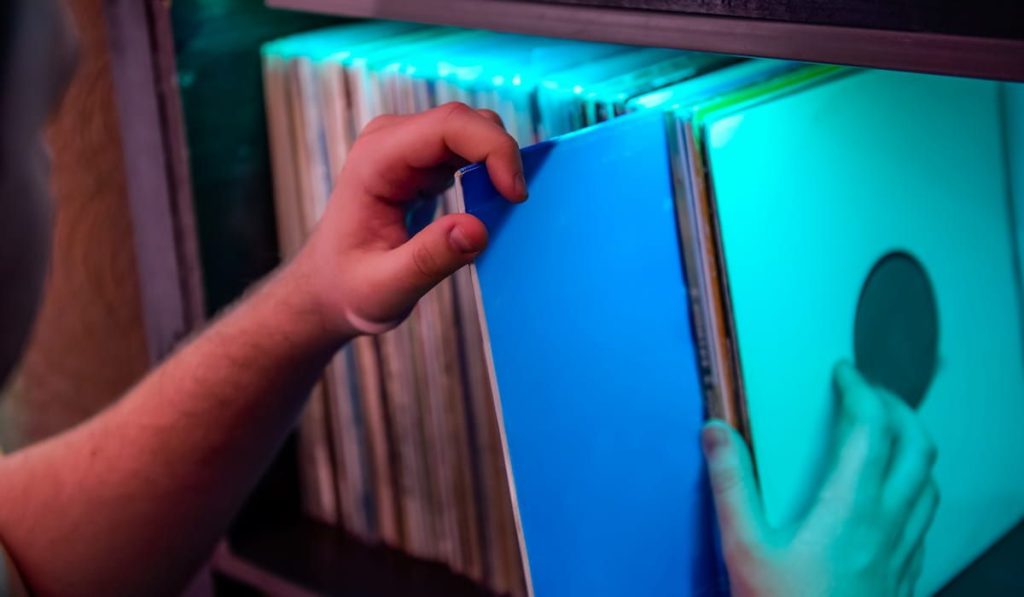
And of course, you’ll probably want a record player. While vinyl records make great decor alone, nothing beats listening to them on your own record player.
Is Vinyl Record Collecting Best Done Alone or In a Group?
Is vinyl record collecting best done alone, or in a group? Well, that depends, do you have friends who share your interest? If so, it can be an enjoyable social activity to go on a record hunt together. You can bring home your finds to listen to, decorate, etc.
Or it can be a hobby that is more personal. You can collect your most favorite artists, listen, and decorate on your own. Taper the vinyl collection to your individual music tastes, art style, etc. Either or.
What to Look for When Collecting Vinyl Records
Good Signs to Look For:
- Luster. When it comes to vinyl records, the shinier, the better. A record that has aged well should retain some luster.
- Tiny hairs or fibers. If you’ve managed to find a record that maintains the tiny, hair-like fibers from production, you have discovered a keeper. These are left over from manufacturing and only remain when a record is rarely removed from its sleeve (which means it’s likely to be in exceptional condition; always double-check, of course).
- Deep grooves. If a record is engraved deeply, with bold grooves, that powerful sound will carry over.
- Faint scratches that you can see but not feel with your finger. In the perfect world, no records would have scratches on them. Sadly, given their age and how often they are traded, many do. There are different kinds of scratches, however. The ones least likely to interfere with your listening experience are those which are faint enough that you can see, but which you are unable to feel with your finger. These will interrupt your stylus far less than scratches that are deeper (if it is noticeable at all).
Bad Signs to Look For:
- The sleeve has bonded to the vinyl. First and foremost, never play a vinyl record with sleeve impressions leftover. This is known as the sleeve bonding to the record and can actually harm the stylus of your record player. How? The sleeve residue will come off onto the stylus, usually permanently, and this can cause it to stick or break.
- Tramlines. When it comes to vinyl records, ‘tramlines,’ that is, scratches that follow the grooves closely, are the second-worst flaw. As you can imagine, these will all-too-easily cause the stylus to go off-track (causing skipping, or your record player may become entirely stuck).
- Warping. If you look at a record from the side, and it appears wavy, it is warped. This may mean that the record will no longer work on a record player.
- Heat damage. Once again, inspect a record from the side; are there any bubbles? These are caused by heat-damage and may also mean the record is broken altogether.
- Faded or with a worn-out look. Faded or worn-looking vinyl records are more likely to be damaged by wear than those that have retained some luster.
- Grooves that are faint or shallow. If the grooves of the record itself are faint or shallow, the sound feedback may also be weak.
- Deep scratches. No matter where they’re located, deep scratches are a bad sign – they will likely cause the record to skip or become stuck.
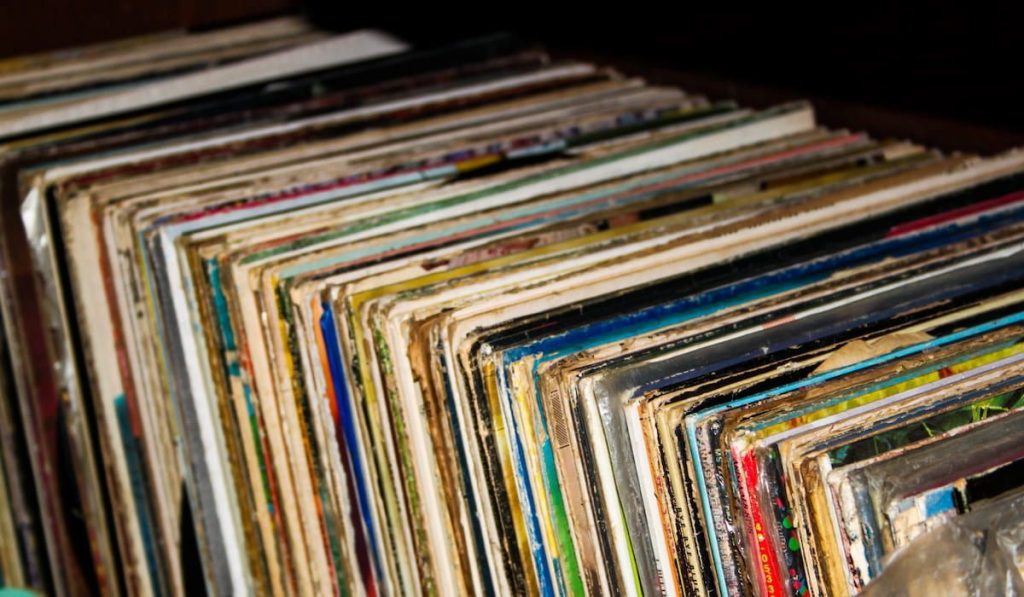
Is Vinyl Record Collecting Expensive?
Record collecting is as expensive – or as affordable – as you make it. If you’re a serious collector, you may find yourself willing to shell out some cash for a particularly rare record.
If you’re more easy-going about it, there are plenty of records sold at rubbish sales, garage sales, second-hand shops, etc. You’re sure to find a good deal.
Some records are exceedingly rare and can cost as much as a hundred dollars (or more).
There are those who consider record collecting an investment, however.
Like many old collectibles, records will increase in value over time, and they can be quite lucrative to resell.
How Do Vinyl Records Work?
Vinyl records, made of PVC, are carved with grooves in the form of sound waves. When the stylus of a record player gently presses into the grooves, it causes vibrations that make the sound waves to emit (in the form of electrical signals). This is the lovely, high-quality music that we hear.
Size
Vinyl records come in three standard sizes: 7-inch, 10-inch, and 12-inch. Why? In order to engrave longer songs, records had to become bigger. Your average record player will almost certainly play 7-inch to 12-inch records, but those capable of playing 10-inch records are more unusual. During your vinyl record hunt, this is important to remember.
Speed
There are three vinyl record speeds: 33 ⅓ RPM (rotations per minute), also known as 33 RPM, 45 RPM, and 78 RPM.
How does speed affect sound quality? The higher the RMP – the more rotations per minute – the greater the amount of information that the stylus receives at once, which makes for richer audio feedback.
Appearance
Most vinyl records you can find will be a solid black. There are also some that are a solid color, some that have pictures or designs, and some that are clear.
Weight
The weight of a record will directly affect its volume and sound quality, and it is better for them to be heavier rather than lighter. This is because it makes the record more stable, with more vibration control. The stylus can press into the grooves more deeply, for playback that is smoother.
Most records weigh between 100 and 200 grams, making those in the upper 100s some of the most highly sought-after.
Grade
Record grading goes as follows: M (Mint), NM (Near Mint), VG++ (Very Good Plus Plus), VG+ (Very Good Plus), VG (Very Good) AKA E (Excellent), VG- (Very Good Minus), G+ (Good Plus), G (Good), F (Fair) or P (Poor).
In order for a record to have real value, it must generally be VG+ or above. They sell for about 85% less when they are only VG or below – and unless it’s exceedingly rare, you may not even want to purchase a Fair or Poor.
Vinyl Record Care
You will definitely want to know about vinyl care if you are going to be a serious vinyl collector. This will keep their condition from deteriorating, so the sound remains loud and clear.
To clean your vinyl records, you will want a vinyl record brush. Use this to gently remove dust, static, etc. Or buy a cleaning kit online like this one from Amazon.
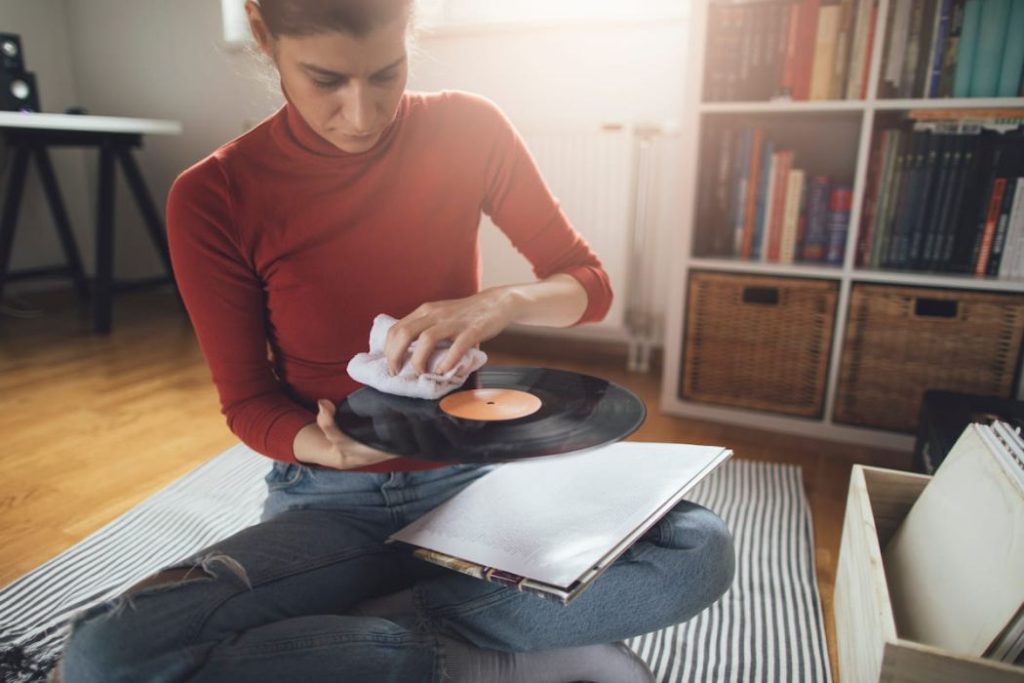
If there are any fingerprints or other smudges, spray a gentle cleaning solution and wipe with circular movements, following the grooves.
Rinse the record with water and wipe dry with a soft cloth (so it does not cause micro-scratches or lint).
Maintain your records by storing them properly when they are not being played on your record player.
Do You Need Lessons in Order to Collect Vinyl Records?
Do you need lessons to get into vinyl record collecting? No, it’s pretty straight-forward; there are some things you will want to know, however.
Be sure to educate yourself on things to look out for (good and bad), and you can easily become a top-notch vinyl record hunter and collector.
Types of Record Players
Record players are known as turntable record players, and there are three kinds available: idler wheel, belt-drive, and direct-drive.
Idler wheel turntables are named for their idler wheel, a rubber wheel which a motor’s shaft rotation to the edge of the record player platter.

As you’ve probably guessed, belt-drive record players used a belt to rotate the platter.
Finally, a direct-drive turntable simply refers to those that have a motor (rather than a belt).
Hobbies That Are Similar
If you like the rating aspect of vinyl records, perhaps you’d be interested in comic book collecting or card collecting, as well! You can hunt down the top-rated ones and similarly display them – properly encased in plastic – as decor.
Or, if it’s the music aspect of vinyl record collecting that appeals, you could collect a more modern music medium, like CDs.
Winding Up
So, what do you think? Is vinyl record collecting the hobby for you?
Go on a record hunt, decorate your home, listen to your favorite artists (or someone new).
Save them to resell when they increase in value, and, last but not least, enjoy the old-fashioned but incomparably pure audio feedback!

